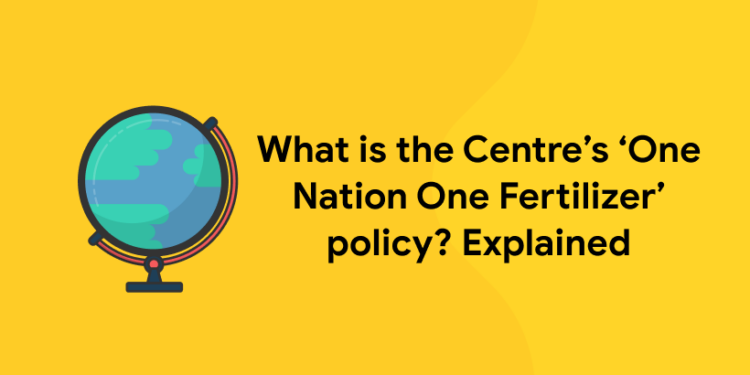Table of Contents
The centre on 24th August 2022 announced the One Nation One Fertilizer Policy. The prefix of One Nation One, is not a new reform to various sectors in India. The centre government is trying their all efforts to make one nation one policies to centralise and codify all the schemes and ventures in the country. Despite the fact that how it affects the federalism, decentralisation, and various sectors, as a competitive aspirant and an Indian general awareness trend analyser one need to specially look into the One Nation One Fertilizer Policy. Through this blog let us explain the basic overview and impact of the One Nation One Fertilizer Policy.
Enroll Entri for Availing More General Awareness for Competitive Examination
One Nation One Fertilizer Policy – A Basic overview
One Nation One Fertilizer policy or scheme is announced by the centre government through the ministry of Chemicals and Fertilizers. On 24 August 2022, the ministry of chemicals and fertilizers announced through a memo announced the introduction of a ‘Single Brand for Fertilizers and Logo’ under the fertilizer subsidy scheme “Pradhanmantri Bhartiya Janurvarak Pariyojna” (PMBJP). It ordered all the fertilizer manufacturing companies, State Trading Entities (STE) and Fertilizer Marketing Entities (FMEs) to rename all the fertilizers such as urea, Muriate of Potash (MOP), Diammonium Phosphate (DAP) etc by putting a prefix to it as Bharath. All the fertilizers thus be renamed to Bharath Urea, Bharath MOP, Bharath DAP etc. The above brand name and the logo for the same has to be displayed in two-third of the Cover of the fertilizer whereas the manufacturing entity’s logo or name is entitled to display on one third of the cover of the fertilizer. The policy thus introduced is imparting a name change or brand change to the existing fertilizers in the market. The policy may seem like just a name change, but the rationale behind doing the same and the consequences of the policy in favour of the sector and against the sector are many.
Why the One Nation One Fertilizer Policy Introduced?
1: Who was the first woman President of India?
This is one of the fundamental questions that comes to our mind when we hear about the policy. We may consider it as a move to nationalise all the fertilizers production under the government but it is not as such. The government has put forward this policy due to two reasons mainly as follows:
- The price of the fertilizers is controlled by the government as of now. In order to benefit the farmers, reducing the price of the fertilizers, especially urea needed to be controlled. The hectic price of the fertilizers is controlled by the government by fixing a fixed MRP for fertilizers. In case of Urea, the MRP is fixed at 10-20% of the cost of production of the fertilizers. In order to do that, 80-90% of the cost of the production are given as subsidies to the manufacturers. The non-urea fertilizers in paper are not controlled by the government but practically they are also controlled by the government. Crores amount has been spent by the government for the manufacturing of the fertilizers.
- In an economic sense, the government not only produces the fertilizers but also decides where it should be sold. By the Fertiliser (Movement) Control Order, 1973, the government decides where the fertilizers are to be distributed. The government provides subsidies for the freight prices, so the manufacturers don’t hesitate to distribute it into far away places. By this the government is able to distribute the fertilizer resources to faraway places where some rural areas are deprived of fertilizers for farming.
Due to the above reasons the government may feel it necessary to showcase the endeavours they put in manufacturing and distributing the fertilizers to the farmers and public. The scheme can be seen as an effort to showcase the effort.
Enroll Entri for Availing More General Awareness for Competitive Examination
Free UPSKILLING Courses!
Take your first step toward mastering in-demand skills, acing interviews, and securing top-tier jobs with Entri's free upskilling courses.
Start Learning!Major criticism to One Nation One Fertilizer Policy
Major flakes have been arising against the One Nation One Fertilizer policy after its introduction. The criticisms are arising from the opposition as well as the manufacturing companies. Some of the criticisms and its reasons are as follows:
- The manufacturing companies have expressed their distress over this policy. This policy will reduce their brand value and they will be hesitant to spend money for the marketing and outreach of the product due the absence of the brand value of the product.
- Since all the products have been included in the single brand, experts have opinionated that it will reduce the competition, quality building and in some cases, it will cause the exiting of the manufactures from the field. The aim of Atmanirbhar (Self reliant India) Bharath will be a far step away due to this initiative.
- It will unwantedly cause a burden on the government. Not the liability to produce the good quality products and keep up with the quality is entrusted with the manufactures. Now the liability has been shifted to the government by its brand name. providing subsidies cannot be said as a supervisory control over the quality assurance. This liability has been unwantedly invited due to this initiative.
Reformation Needed for One Nation One Fertilizer Policy
The experts of the Indian economy and the particular sectors suggest some reformation or fundamental change of approach to this policy in order to have ultimate benefit to the farmers. Now the farmers are indirectly benefited by the subsidy scheme as the MRP is regulated by subsidising the fertilizers. Rather than this approach the experts suggest initiating farmers Direct Benefit Transfer (DBT). The DBT can reduce the deprivation of small-scale farmers being not benefited from the fertilizer subsidy scheme and can reduce the hectic cores of amount allocation on each budget for fertilizer subsidies.
Enroll Entri for Availing More General Awareness for Competitive Examination
Conclusion.
One Nation One Fertilizer has got many rationales as discussed above. Amidst its criticism one thing can be assured. The major rationale behind the policy was to know the efforts of the government in the sector. That mission has been accomplished and this blog is the evidence for that. Hope all the readers have got a fundamental idea about the one nation one fertilizer policy giving it a broad dimension to the development of the Indian Agriculture sector. Enrol Entri for availing more general awareness. Keep studying, Keep winning.














